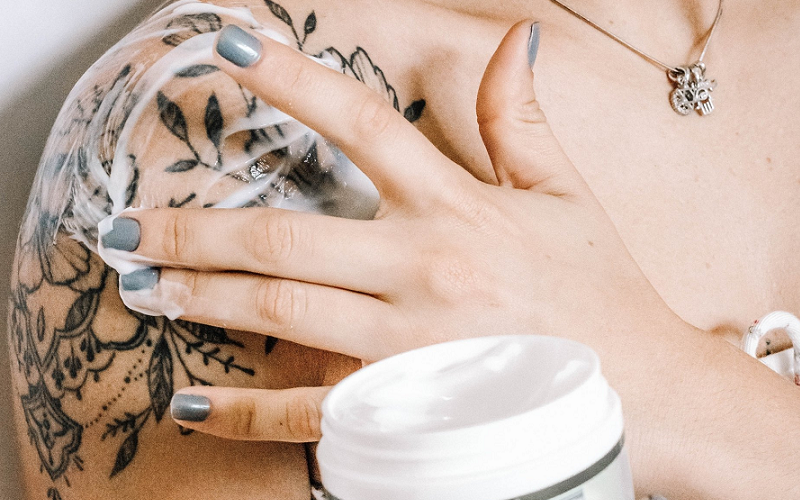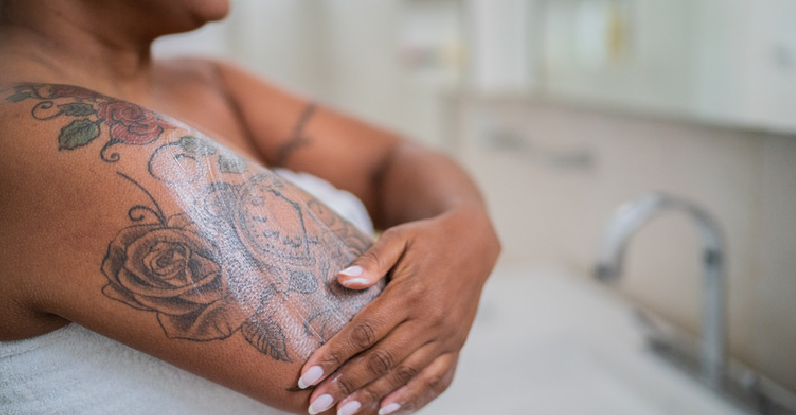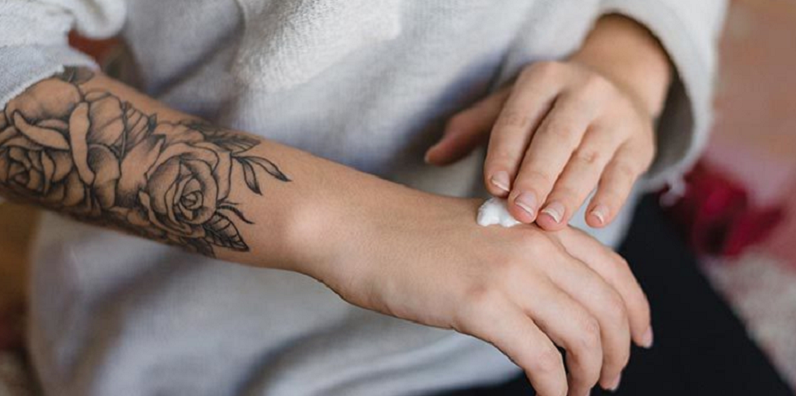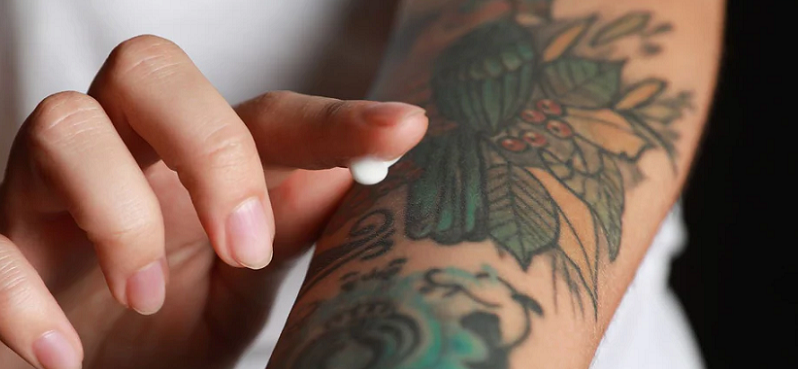
In an age where personal expression and body art have intertwined, tattoos have transcended from mere fashion statements to symbols of identity and stories etched onto skin. With the increasing number of people joining the inked community, there’s a growing need to understand and maintain the unique demands of tattooed skin. While your tattoo artist plays their part in delivering that perfect piece, your role in ensuring its vibrancy and longevity is just as crucial. This goes beyond the immediate aftercare; it’s about a committed skincare regimen tailored for your inked skin.
Contents
- The Science Behind Tattooed Skin
- Immediate Tattoo Skin Aftercare: The First 48 Hours
- The Post-Tattoo Skin Healing Process: Days to Weeks
- Long-Term Post-Tattoo Skincare for Vibrant Tattoos
- References
The Science Behind Tattooed Skin
When one considers the delicate balance of the skin’s structure and functions, introducing ink through a tattoo needle becomes a profound act, scientifically and aesthetically. Before diving into the care and nurturing of tattooed skin, it’s essential to understand the underlying processes and the changes that tattoos bring about.
The Tattooing Process and Its Effect on the Skin
At its core, tattooing involves inserting ink into the skin’s dermal layer using sharp needles. As the needle punctures the outermost layer, the epidermis, it reaches the second layer, the dermis, where the ink is deposited. The dermis, housing blood vessels and nerves, is stable, ensuring the tattoo remains mostly unaltered over time.
When this invasive procedure is carried out, the body perceives it as a wound, triggering an immune response. White blood cells, known as macrophages, rush to the site, attempting to “clean up” the foreign ink particles. However, the ink particles are too large for these cells to consume fully. As a result, the ink gets trapped in the dermis, visible through the outer epidermal layer, presenting us with what we recognize as a tattoo.
How Tattooed Skin Differs from Non-Tattooed Skin
Tattooed skin undergoes several changes post-procedure. Here’s a breakdown:
Increased Sensitivity
Freshly tattooed skin is more sensitive. The trauma from the needle, combined with the body’s healing response, can cause redness, swelling, and a feeling of warmth.
Scab Formation
As part of the natural healing process, the body may form scabs over the tattooed area. These protect the skin underneath, allowing it to heal. It’s crucial not to pick at these scabs, as doing so can affect the tattoo’s outcome [1].
Changes in Texture
Some individuals may notice a change in skin texture in the tattooed area. It could feel slightly raised or have a different tactile feel compared to surrounding skin.
Alteration in Skin Barrier Function
The skin acts as a barrier, protecting the body from external aggressors like bacteria and environmental irritants. Tattooing can temporarily compromise this barrier function, making the skin more susceptible to external factors and infections.

Immediate Tattoo Skin Aftercare: The First 48 Hours
The first two days post-tattooing can be likened to the early stages of nurturing a plant. Just as a sapling requires immediate watering, care, and protection, your fresh ink demands meticulous attention during this initial phase. These formative hours dictate not only the healing process but also the tattoo’s long-term appearance. Let’s delve deeper into the essential steps and precautions you should take during this pivotal period.
Why the First 48 Hours are Critical
The moment the last stroke of the needle concludes, and your artist wraps up your tattoo, the healing process commences. During the first 48 hours:
Inflammation Peaks
The body’s initial response to the ‘trauma’ caused by the tattoo needle is inflammation. This is a natural reaction and manifests as redness, swelling, and warmth around the tattooed area [2].
Risk of Infection
With the skin’s natural barrier disrupted by the tattooing process, the susceptibility to external contaminants increases. Immediate aftercare aims to minimize this risk.
Ink Setting
As the skin starts healing, the ink begins to settle in the dermis. Proper care ensures that the design remains as intended, without unnecessary fading or blurring.
Dos and Don’ts
During these crucial hours, it’s imperative to know what actions promote healing and which ones could be detrimental.
Cleaning the Tattoo
Do: Gently cleanse the tattooed area with lukewarm water and a mild, fragrance-free soap, using your fingertips in a soft, circular motion. Pat dry with a clean towel or let it air dry.
Don’t: Scrub the area, use hot water, or dry aggressively with a towel.
Moisturizing
Do: Apply a thin layer of specialized tattoo ointment or moisturizer (as recommended by your artist) to keep the skin hydrated, facilitating healing.
Don’t: Slather on thick layers of ointment, as this can suffocate the skin and lead to pimples.
Avoiding Certain Activities and Environments
Do: Keep the tattooed area dry and clean. Wear loose, breathable clothing to avoid excessive friction.
Don’t: Submerge the tattoo in water (like baths, swimming pools, or hot tubs). Avoid direct sunlight and refrain from workouts that cause excessive sweating in the tattoo area.

The Post-Tattoo Skin Healing Process: Days to Weeks
As the immediate aftermath of getting a tattoo fades, the skin embarks on a longer journey of repair and regeneration. This phase, spanning days to several weeks, witnesses the skin undergoing various transformations. It’s a symphony of cellular processes working harmoniously to mend the disrupted tissue while setting the ink in place. Understanding this evolution allows for informed care, ensuring that both the skin and the tattoo emerge from this period looking their best.
Phases of Tattoo Healing
Every individual’s body and skin type are unique, which means the precise duration and progression of the healing stages can vary. However, most tattoos tend to follow a general pattern.
Initial Healing (Days 1-6)
This phase is marked by noticeable redness, swelling, and a slight oozing of ink and plasma. The tattooed area may feel warm and sore, akin to a sunburn [3].
Itching and Peeling (Days 7-14)
As the outer layer of skin begins to heal, it often results in itching and peeling, much like the shedding experienced after a sunburn. Underneath this flaking layer, one may notice the tattoo’s colors looking slightly cloudy; this is a natural part of the process.
Deep Tissue Healing (Weeks 2-4)
While the skin’s surface might seem fully healed by the end of the second week, deeper layers continue to repair. It’s essential to maintain care routines even if the tattoo appears healed on the surface.
Signs of Proper Healing Versus Signs of Complications
While tattoos inherently cause skin irritation, differentiating between normal healing and potential complications is vital.
Proper Healing
- Mild redness and swelling during the first week.
- Gentle peeling and itching around the one-week mark.
- Gradual lightening of the cloudiness and full clarity by the end of the month.
Potential Complications
- Excessive redness, swelling, or warmth lasting beyond the initial week.
- Presence of yellow or green pus, which could indicate an infection.
- Hard, raised scars, suggesting keloid formation.
- Persistent pain or severe itching.
If any signs of complications arise, it’s crucial to consult with a medical professional or the tattoo artist promptly [4].
Recommended Products and Their Benefits
Maintaining optimal skin health during the healing phase is augmented by the right products:
Antibacterial Soaps
Purpose: To cleanse the tattooed area gently, ensuring no bacteria or foreign contaminants hamper the healing.
Benefit: Reduces the risk of infection and ensures the skin remains clean without causing excessive dryness.
Healing Ointments
Purpose: To offer a protective barrier that keeps pathogens out while locking moisture in.
Benefit: Promotes faster skin recovery, minimizes scab formation, and reduces itching.
Moisturizers Suitable for Tattooed Skin
Purpose: To hydrate the healing skin, ensuring its elasticity and health.
Benefit: Prevents excessive dryness, reduces itching, and maintains the vibrancy of the tattoo.

Long-Term Post-Tattoo Skincare for Vibrant Tattoos
The journey of preserving the magnificence of your tattoo doesn’t conclude once the initial healing phase is over. Like a timeless piece of art, tattoos require consistent attention to ensure they remain as vivid and sharp as they were when first inked. The canvas, in this case—your skin—also necessitates regular care to retain its health and resilience.
The Role of Sun Protection
Exposure to the sun’s ultraviolet rays stands as one of the prime culprits behind tattoo fading. Here’s what you need to know.
UV Radiation
UV rays can penetrate the skin’s surface and break down the ink particles in tattoos, causing them to scatter and fade over time [5].
Sunscreen
It’s essential to apply a broad-spectrum sunscreen of SPF 30 or higher to the tattooed area, especially when anticipating sun exposure. Look for sunscreens labeled “broad-spectrum” to ensure protection against both UVA and UVB rays.
Reapplication
If you’re spending prolonged hours in the sun, remember to reapply sunscreen every two hours, or more frequently if swimming or sweating.
Keeping the Skin Hydrated
Hydrated skin provides a radiant backdrop for tattoos, ensuring they remain vibrant and clear.
Moisturizing
Regularly applying a good-quality moisturizer helps maintain skin elasticity and prevents dryness.
Water Intake
Hydration isn’t only skin-deep. Consuming an adequate amount of water daily ensures the skin remains supple, further enhancing the appearance of tattoos.
Exfoliation’s Role in Maintaining Tattoo Clarity
Dead skin cells can accumulate on the skin’s surface, rendering tattoos dull or cloudy.
Routine Exfoliation
Gentle exfoliation once a week can help remove these dead skin cells, revealing the brighter tattoo underneath. However, avoid aggressive scrubbing which can harm the tattoo and skin.
Choosing the Right Product
Look for mild exfoliants, preferably with natural ingredients, to ensure the skin isn’t overly irritated in the process.
Yearly Touch-Ups and Professional Advice
Even with the best care, tattoos can naturally fade or lose some of their sharpness over the years.
Consultation
Regularly checking in with your tattoo artist can help identify any areas that might benefit from a touch-up. They’ll provide expert insight into maintaining the art’s integrity.
Recoloring
Some tattoos, especially color ones, might need occasional recoloring to keep them looking fresh and vivid.
References
[1] Tattoo aftercare: Tips and instructions
[2] Caring for Tattooed Skin
[3] 9 Best Lotions to Heal a New Tattoo, According to Experts
[4] Tattoo Aftercare Tips That Will Help Your New Ink Heal Properly
[5] Best Tattoo Lotions to Heal New Ink Beautifully, According to Experts
